NANO-TECHNOLOGY
BACKGROUND & INTRODUCTION
“Nanotechnology is an idea that most people simply didn’t believe.” – Ralph Merkle
- Nanotechnology is a field of science and technology that deals with the design, production, and application of materials and devices with dimensions in the nanometer scale.
- It is an interdisciplinary field that involves physics, chemistry, biology, and engineering.
- The field has the potential to revolutionize many areas of science and technology, such as medicine, electronics, energy, and material science.
Standard Units of Measurements
- The history of measurement systems dates back to ancient civilizations where measurements were based on body parts, such as the length of a finger or the width of a hand. These systems were not standardized, and measurements varied from place to place.
- We have also seen that the people of the Indus Valley civilization must have used very good measurements of length, because we see evidence in excavations of perfectly geometrical constructions.
- In 1790, the French created a standard unit of measurement called the metric system that succeeded the decimalized system. For the sake of uniformity, scientists all over the world have accepted a set of standard units of measurement. The system of units now used is known as the International System of Units (SI units).
- The International System of Units (SI) uses prefixes to denote powers of 10 for units of measurement. These prefixes can be used to express very large or very small numbers. The most common prefixes are presented in Table 1.
- The SI unit of length is a meter (m).
Table: Prefix for power of 10
| Prefix | Powers of 10 | Prefix | Powers of 10 |
| exa (E) | 10^18 | deci (d) | 10^-1 |
| peta (P) | 10^15 | centi (c) | 10^-2 |
| tera (T) | 10^12 | milli (m) | 10^-3 |
| giga (G) | 10^9 | micro (μ) | 10^-6 |
| mega (M) | 10^6 | nano (n) | 10^-9 |
| kilo (k) | 10^3 | pico (p) | 10^-12 |
| hecto (h) | 10^2 | femto (f) | 10^-15 |
| deca (da) | 10^1 | atto (a) | 10^-18 |
General Information About Length Scale
- The macroscopic scale is the scale of objects or phenomena that are large enough to be visible with the naked eye.
E.g. Buildings, Man, Apple, Ant (small insects), etc.
- The microscopic scale refers to objects or phenomena that require a magnifying optical instrument to see them clearly, as they are smaller than what the naked eye can see easily.
E.g. Animal/Plant cell, RBC, WBC, Bacteria, etc.
- The nanoscopic scale/nanoscale usually refers to the scale of objects or phenomena smaller than the microscopic scale, usually cited as 1-100 nanometers and requiring an electron microscope instrument to see them clearly.
E.g. DNA, RNA, Protein, Viruses (SARS-CoV-2 ~ 50 nm).
- The atomic scale refers to the size of individual atoms, which are the basic building blocks of matter. Atoms are incredibly small, typically measuring only a few angstroms (Å – 10^-10 m) in diameter. We need an advanced electron microscope to see them clearly.
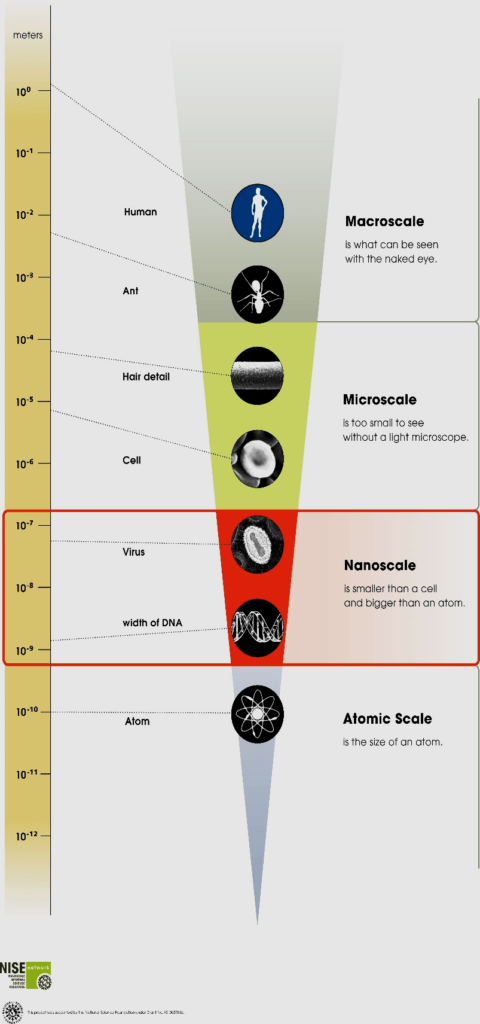
Nano Science and Technology
Nano, a prefix that means “dwarf” in Greek, is shorthand for nanometer (10^-9), i.e., one-billionth of a meter.
- Nanoparticle is any material having at least one of its dimensions in the range of 1-100 nm. When these particles combine, they develop nanomaterials.
- Nanoscience is the study of nanomaterials, their properties, and related phenomena.
- Nanotechnology is the application of nanoscience conducted at the nanoscale, which is about 1 to 100 nanometers.
- Nanotechnology is used for the creation of useful materials, structures, devices, and systems through the manipulation of shape and size of matter on this scale.

What happens at the nanoscale?
- At the nanoscale, matter behaves differently than at larger scales due to quantum effects, i.e., matter follows the laws of quantum physics, which is very different from the laws of Classical physics.
- This can result in the manifestation of novel phenomena and properties, including changes in:
- Physical properties (e.g., melting point),
- Chemical properties (e.g., reactivity),
- Electrical properties (e.g., conductivity),
- Mechanical properties (e.g., strength),
- Optical properties (e.g., light emission).
- In addition, the large surface area-to-volume ratio at the nanoscale can lead to increased reactivity compared to bulk materials.
Common examples:
- Gold becomes red, green at nanoscale.
- Aluminium explodes (Nano Explosion).
- Plastic conducts electricity.
- Carbon/silicon becomes a very good conductor of electricity at the nanoscale.
Surface area to Volume Ratio of nanomaterials

| Reasons for changing chemical properties at nanoscale:
● As surface to volume ratio increases. ● A greater amount of a substance comes in contact with surrounding material. ● This results in better catalysts, since a greater proportion of the material is exposed for potential reaction. |
Nanomaterials have a relatively larger surface area when compared to the same mass of material produced in a larger form. This large surface area means greater contact area, which increases the reaction rate.
CLASSIFICATION OF NANOMATERIALS
Classification of nanomaterials based on the formation element:
- Organic nanomaterials – consisting of element carbon, e.g., Carbon nanotubes, etc.
- Inorganic nanomaterials cover a broad range of substances, including elemental metals, metal oxides, and metal salts. g., Silver, Gold nanoparticles/materials.
Classification based on generation – Natural and manmade:
- Naturally occurring nanoparticles can be found in volcanic ash, ocean spray, fine sand, and dust particles, and even biological matter (e.g., viruses).
- Manmade / Synthetic nanoparticles – fall into two general categories: “incidental” and “engineered” nanoparticles.
DIMENSIONS OF NANOMATERIALS

This nanomaterial classification is based on the number of dimensions of a material, which are outside the nanoscale (<100 nm) range.
- 0-D: All dimensions at the nanoscale (e.g., Quantum Dots, nanocrystals)
- 1-D: Two dimensions at the nanoscale. One dimension at the microscale or macroscale. (e.g., Carbon Nano Tube, quantum wire)
- 2-D: One dimension at the nanoscale. Two dimensions at the microscale or macroscale. (e.g., Graphene, quantum well)
- 3-D: No dimension at the nanoscale. All dimensions at the microscale/macroscale. (e.g., Bulk material)

- Quantum dots spheroid nanocrystals (0-D)
- Carbon nanotube – CNT (1-D) (Cylindrical type)
- Graphene (2-D) (Sheet type)

CHRONOLOGICAL RECAP OF MODERN NANOTECHNOLOGY
Nanotechnology as a concept was first introduced in 1959 by Nobel Prize-winning physicist Richard P. Feynman. (Famous lecture: “There is plenty of room left at the bottom”).
The term “nanotechnology” was coined by Norio Taniguchi of Tokyo Science University, Japan, in 1974.
In the 1980s, two major breakthroughs sparked the growth of nanotechnology:
- The invention of the scanning tunneling microscope (STM) (modern Electron microscope) in 1981 and the discovery of fullerene in 1985. In 1986, the technological significance of the nanoscale was promoted by K. Eric Drexler in his famous book “Engines of Creation: The Coming Era of Nanotechnology”.
- This momentum continued with the discovery of carbon nanotubes in 1991. The field advanced further in 2004 when graphene was rediscovered, isolated, and thoroughly investigated, solidifying the foundation for future innovations in nanotechnology.

NANOTECHNOLOGY APPROACHES AND NANO MANUFACTURING
It is the process of designing and fabricating nanoscale materials and devices with specific properties and functions.
It involves the use of nanotechnology to manipulate and control materials at the atomic or molecular scale, enabling the creation of advanced materials, structures, and systems with unique properties and applications.
On the basis of technique, nano materials can be manufactured into 3 parts:
- The Top-down approach of nanotechnology:
- This involves molding or etching materials into smaller components.
g., Electronics industries.
- This involves molding or etching materials into smaller components.
- The Bottom-up approach of nanotechnology:
- This involves assembling structures atom-by-atom or molecule-by-molecule.
g., Biotechnology, Medicine.
- This involves assembling structures atom-by-atom or molecule-by-molecule.
- Hybrid Approaches – combination of top-down and bottom-up approach
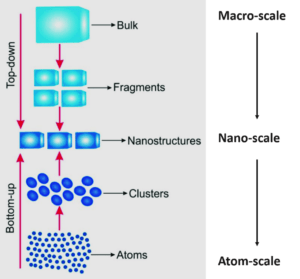
EVOLUTION OF NANOTECHNOLOGY IN INDIA
The 9th Five-Year Plan (1998-2002) had mentioned for the first time about nano materials.
Subsequently, the National Nanoscience and Nanotechnology Initiative (NSTI) was launched in October 2001 under the aegis of the Department of Science and Technology (DST).
- The motive of launching NSTI in 2001 was to create research infrastructure and promote basic research in nanoscience and nanotechnology.
The Eleventh Five-Year Plan (2007-2012) categorically mentioned projects to create high-value and large-impact socio-economic delivery involving nano materials and nano devices in health and disease. The 12th Five-Year Plan strengthened application-based initiatives.
Nano Mission
- In 2007 (during the 11th Five-Year Plan), a Mission on Nano Science and Technology (Nano Mission – NSTM) was launched by the DST to foster, promote, and develop all aspects of nanoscience and nanotechnology, which have the potential socio-economic benefits to the country.
- It is an umbrella program for capacity building in this field.
Salient features of the Nano Mission:
- The Department of Science and Technology (DST) is the nodal agency for the implementation of this mission.
- It will be steered by a Nano Mission Council, chaired by an eminent scientist. The current chairperson is C.N.R. Rao.
- The technical program of the Nano Mission is also being guided by two advisory groups, viz., the Nano Science Advisory Group (NSAG) and the Nano Applications and Technology Advisory Group (NATAG).
- Phase 1 – 2007-12: An allocation of 1000 crore for five years.
- Phase 2 – 2012 – still running: Allocation of 650 crore for five years (2012-17), with year-wise budgetary allocation.
The objectives of the mission are:
- Basic Research Promotion.
- Infrastructure Development for Nano Science & Technology Research.
- Nano Applications and Technology Development Programs – to involve the industrial sector through Public-Private Partnership (PPP) ventures.
- Human Resource Development.
- International Collaborations.
Outcomes and significance of the mission:
- As a result of the efforts led by the Nano Mission, today, India is among the top five nations in the world in terms of scientific publications in nanoscience and technology.
- The Nano Mission has established national dialogues to promote R&D in the development of standards for nanotechnology and for laying down a National Regulatory Framework Road-Map for Nanotechnology (NRFR-Nanotech).
Other initiatives:
- National Nanotechnology Institutes: The government has identified three cities—Bangalore, Mumbai, and Kolkata—for the promotion and development of nanotechnology, by setting up the Indian Institute of Nano Sciences (IINS) at these three locations.
- The INSPIRE scheme (DST) supports research fellows to work in interdisciplinary nanotechnology, nanoscience, and nano-biotechnology areas.
NANOMATERIALS AND CARBON ALLOTROPES
Allotropes are different structural forms of the same element and can exhibit quite different physical properties and chemical behaviors.
- Carbon exhibits many allotropic forms; both crystalline as well as amorphous.
- Diamond and graphite are two well-known crystalline forms of carbon.
- Coal, coke, charcoal, and soot (carbon black) are amorphous carbon.
- A third form of carbon is known as fullerenes

-
- Covalent bond: It is formed by equal sharing of electrons from both participating atoms.
- Van der Waals forces: In molecular physics and chemistry, van der Waals forces are weak, distance-dependent interactions between atoms or molecules. Unlike ionic or covalent bonds, they do not result from chemical bonds and are more easily disturbed.
FULLERENES (1985) – 0-D
- Fullerene is a type of carbon allotrope that consists of a hollow cage or tube of carbon atoms connected by single and double bonds. The most common and stable fullerene is C₆₀, which has a spherical shape and is also known as buckminsterfullerene or buckyball, named after Buckminster Fuller.
- In 1985, the third allotrope form of carbon known as fullerenes was discovered by W. Kroto, E. Smalley, and R. F. Curl. For this discovery, they were awarded the Nobel Prize in 1996.
- Fullerenes are made by the heating of graphite in an electric arc in the presence of inert gases such as helium or argon, followed by the condensation of vapor.
- These molecules have very high tensile strength and bounce back to their original shape.
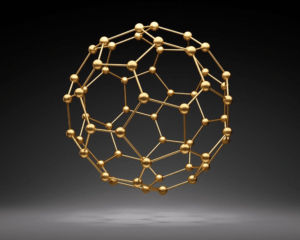
Potential uses of Fullerene:
Molecular electronics:
- Due to its high electron affinity, conductivity, and photoconductivity, fullerene can have applications in electronics devices such as rectifiers, switches, transistors, and photovoltaic devices. Fullerene can also form molecular networks and junctions with other nanomaterials, such as carbon nanotubes and graphene.
Biomedicine / Healthcare / Medical Field:
- Fullerene can be used as a light-activated antimicrobial agent (antibacterial and antiviral), as it can generate reactive oxygen species upon irradiation that can kill bacteria and viruses.
- Fullerene can also act as a targeted drug and gene delivery vehicle, as it can encapsulate or conjugate with various biomolecules and cross biological membranes.
- Fullerene can also be used as a high-performance MRI contrast agent, X-ray imaging contrast agent, and photodynamic therapy agent and antioxidant, due to its magnetic properties, high electron density, photosensitization ability, and radical scavenging ability.
Cosmetic:
- Fullerene can be used as an ingredient in cosmetic products, such as creams, lotions, gels, and masks, to improve skin health and appearance. Fullerene can protect the skin from UV damage, inflammation, aging, and acne by acting as an antioxidant, anti-inflammatory, and antibacterial agent.
Surface coating:
- Fullerene can be used as a coating material for various substrates, such as metals, ceramics, polymers, and glass, to enhance their mechanical, thermal, electrical, and optical properties. Fullerene can also impart corrosion resistance, wear resistance, self-cleaning ability, and biocompatibility to the coated surfaces.
Lubricant:
- Fullerene can be used as a lubricant additive to reduce friction and wear between moving parts. Fullerene can also improve the stability and performance of the base lubricant by preventing oxidation and degradation.
Other potential uses:
- Polymer-fullerene composite solar cells, hydrogen gas storage, etc.
Carbon Nanotubes (1991) – 1D
- Sumio Iijima inspired the world with his discovery of new carbon nanotube materials in 1991.
- Carbon nanotubes (CNTs) are an allotrope of carbon – they are cylindrical hollow fibers, comprised of a single sheet of graphene (a two-dimensional hexagonal lattice of carbon atoms) having a diameter of 5 to 100 nanometers with lengths generally in the range of tens of microns.
- CNTs are cylindrical nanostructures of carbon atoms with extremely light weight, and extraordinary mechanical, electrical, thermal, and optical properties. CNTs can be single-walled (SWNTs) or multi-walled (MWNTs), depending on the number of concentric carbon layers.
- Due to these novel properties, CNTs are potentially useful in a wide variety of applications in electronics, optics, and other fields of materials science.

Potential uses of CNTs:
Electronics:
- CNTs can be used to make nanoscale transistors, diodes, wires, interconnects, and electrodes, due to their high electrical conductivity, current carrying capacity, and quantum effects.
- CNTs can also form heterostructures with other nanomaterials, such as graphene and semiconductors, to create novel electronic devices with enhanced functionalities.
Energy:
- CNTs can be used to improve the performance and efficiency of batteries, supercapacitors, fuel cells, and solar cells, due to their high surface area, charge storage capacity, and charge transfer ability.
- CNTs can also enable the development of new energy storage and generation technologies, such as CNT-based nanogenerators and thermoelectric devices.
Biomedicine / Healthcare / Medical Field:
- CNTs can be used for various biomedical applications, such as antimicrobial agents, targeted drug delivery, gene therapy, biosensing, imaging, tissue engineering, and wound healing, due to their biocompatibility, biofunctionalization, electrical, and optical properties. CNTs can also act as a photothermal agent, photoacoustic agent, and antioxidant in cancer diagnosis and therapy.
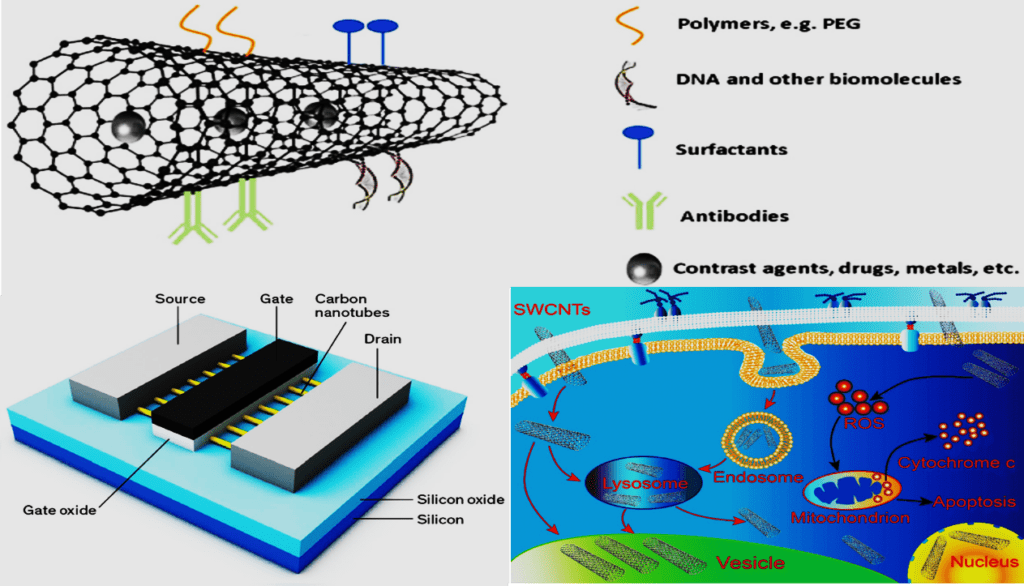
Composites and coatings:
- CNTs can be used to enhance the mechanical, thermal, and electrical properties of various materials, such as metals, ceramics, polymers, glass, wind-turbine blades, and marine turbines. CNTs can also impart corrosion resistance, wear resistance, self-cleaning ability, and biocompatibility to the composite and coated materials.
Membranes/Filtration/Separation:
- CNTs can be used to make ultra-thin and selective membranes for gas separation, water purification, desalination, and ion transport.
Other potential uses:
- Defence, space applications, aerospace industry, automotive industry, sports items, renewable energy sector, paint industry, food processing, and agriculture, etc.
Graphene (2004) – 2-D – ‘Wonder’ Material:
- First discovered in 1962, rediscovered, isolated, and characterized in 2004 by Andre Geim and Prof. K. Novoselov. It is extracted from graphite, consisting of a one-atom-thick layer.
- Andre Geim and Novoselov were awarded the Nobel Prize in Physics in 2010 for the rediscovery of graphene.
- Graphene is a carbon allotrope consisting of planar sheets (2D structure), which are one atom thick, with the atoms arranged in a honeycomb-shaped lattice (a hexagonal pattern).
- Graphene is the thinnest, strongest, and most conductive material ever discovered.
- Novel properties of graphene include being a very good conductor of electricity and heat, stronger than steel (around 200 times), very light, and nearly transparent.
- Graphene has very high heat resistance of up to 3500°C (not easily melted). It also has high chemical reactivity.

| Knowledge Base: Discovery of Graphene
The excitement surrounding graphene soared since Sir Andre Geim and Sir Kostya Novoselov were awarded the 2010 Nobel Prize in Physics, “for groundbreaking experiments regarding the two-dimensional material graphene.” Geim and Novoselov extracted graphene from graphite using the “scotch tape” method, to obtain a piece of graphene (or carbon) one atom thick.
|
Potential uses of graphene:
Electronics:
- Graphene can be used to make faster, smaller, and more flexible transistors, semiconductors, bendable phones, sensors, and displays, due to its high electrical and thermal conductivity, optical transparency, and mechanical flexibility.
- Graphene can also form heterostructures with other nanomaterials, such as carbon nanotubes and semiconductors, to create novel electronic devices with enhanced functionalities.
Energy:
- Graphene can be used to improve the performance and efficiency of batteries, supercapacitors, fuel cells, and solar cells, due to its high surface area, charge carrier mobility, and chemical stability.
- Graphene could dramatically increase the lifespan of a traditional lithium-ion battery, meaning devices can be charged quicker and hold more power for longer.
- Graphene can also enable the development of new energy storage and generation technologies, such as graphene-based nanogenerators and thermoelectric devices.
Biomedicine:
- Graphene can be used for various biomedical applications, such as antimicrobial agent, targeted drug delivery, gene therapy, biosensing, imaging, tissue engineering, and wound healing, due to its biocompatibility, biofunctionalization, electrical, and optical properties. Graphene can also act as a photothermal agent, photoacoustic agent, and an antioxidant in cancer diagnosis and therapy.

Composites and coatings:
- Graphene can be used to enhance the mechanical, thermal, electrical, and barrier properties of various materials, such as metals, ceramics, polymers, and glass. Graphene can also impart corrosion resistance, wear resistance, self-cleaning ability, and biocompatibility to the composite and coated materials.
Membranes/Filtration/Separation:
- Graphene can be used to make ultra-thin and selective membranes for gas separation, water purification, desalination, and ion transport.
Other potential applications:
- Defence, space applications, aerospace industry, automotive industry, sports items, renewable energy sector, paint industry, food processing, and agriculture, etc.
| Knowledge Base: Carbon fibres
● Carbon fibre is a material made of thin strands of carbon atoms that have a diameter of about 5 to 10 micrometers. These materials are very strong, stiff, and light. Carbon fibre can be used to make a composite material that has many advantages over other materials, such as steel or aluminium. Carbon fibre is used in many industries and applications, such as aerospace, automotive, military, and sports. |
Other Nanomaterials And Devices
- Nanocrystals: They have all dimensions smaller than 10 nm, are also described as nanodots/quantum dots, and have optical and electronic properties that differ from larger particles due to quantum mechanics.
- Quantum dots can be made from a range of materials. Commonly used materials include carbon, zinc sulphide, lead sulphide, cadmium selenide, and indium phosphide.

- Quantum dots are sometimes called ‘artificial atoms’ because they have discrete energy levels like atoms, and they can emit light of different colours depending on their size and shape.
- They have potential applications in various fields such as solar cells (quantum dot solar cell), Light-emitting diodes (LEDs), display (QD-LED), lasers, quantum computing, and medical imaging. In the medical field, quantum dots can also be used for drug delivery, biosensing, biomedical imaging, and photothermal therapy.

| Explainer: Nobel Prize-Chemistry 2023
● The 2023 Nobel Prize in Chemistry has been awarded to Moungi G. Bawendi, Louis E. Brus, and Alexei I. Ekimov for the discovery and synthesis of nanometer-sized semiconductor crystals called quantum dots. ● Quantum dots are particles that are a few nanometers wide. They exhibit unique optical properties due to their small physical size. They have the same structure and atomic composition as bulk materials, but their properties can be tuned using a single parameter: the particle’s size. ● These nanoparticles have wide-ranging applications across fields like electronics, advanced surgery, and quantum computing. |
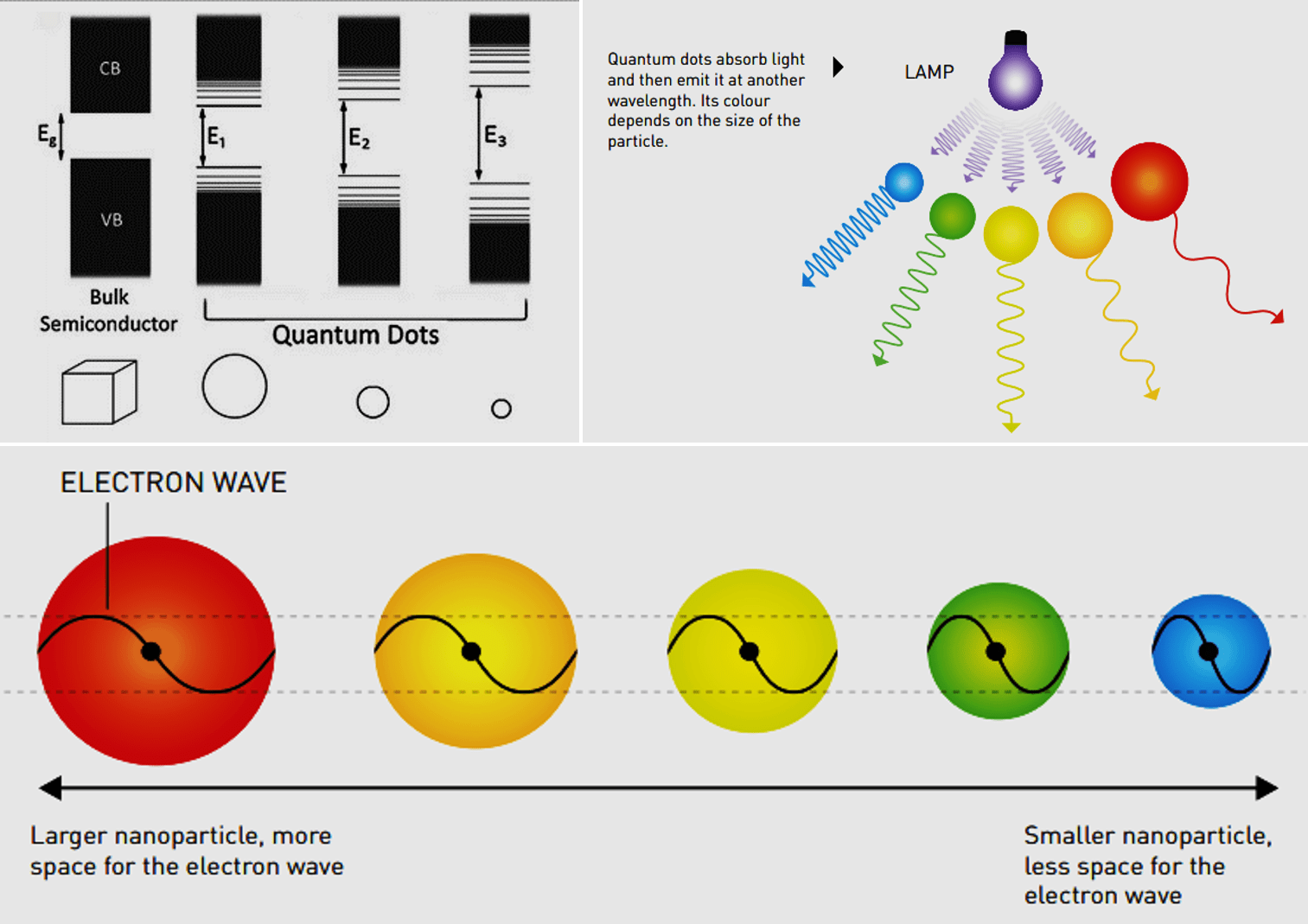
- Nano shell / Nano bead
- Nanoshell: A type of spherical nanoparticle (beads) consisting of a dielectric core which is covered by a thin metallic shell (usually nanogold).
- They can absorb near-infrared light (which can easily penetrate several centimeters of human tissue). The absorption of light by the nanoshell creates an intense heat that is lethal to cells.
- Application – Cancer treatment

- Nanopores: A pore/cavity with dimensions of only a few nanometers.
- Used in making DNA sequencing more efficient and to address errors in genes.

- Nanofilms: Thin layers of material spanning from a fraction of a nanometer to several micrometers in thickness.
- Can be used as barrier materials to prevent spoilage by microbes and oxygen absorption. These specific films are used to prevent and reduce the possibility of food drying and spoilage.
- Can also be used in anti-counterfeiting of money and goods.
- Nanofilters: Nanoporous membranes are suitable for mechanical filtration with extremely small pores smaller than 10nm (“nanofiltration”).
- Nanofiltration is mainly used for the removal of ions or the separation of different fluids.
- Magnetic nanoparticles offer an effective and reliable method to remove heavy metal contaminants from wastewater.
- Nanodrugs: In the future, patients will drink fluids containing nanorobots/nanobots programmed to attack and reconstruct the molecular structure of cancer cells and viruses to make them harmless.
APPLICATION OF NANOTECHNOLOGY
Nanotechnology is also described as the “Future Renaissance” because it will bring highly diverse disciplines onto a common platform, which is demonstrated in the form of NBIC (Nanotech Biotech Information Communication). Examples include nano-electronics and DNA computing.
The current and potential applications for nanoparticles are growing and cover an extremely broad range of markets and industries, including biomedical and cancer treatment, renewable energy, environmental protection, pharmaceuticals, agriculture, personal care, surface coatings, plastics, textiles, food, building materials, electronics, defense, automotive, etc.
Health Care
- In the 21st century, the health sector is facing various challenges, such as cancer and its diagnosis, cardiovascular disease, the development of vaccines, antimicrobial resistance, and more. These challenges are complex and need innovative solutions. Here, Nanotechnology-based Nanomaterials have the potential to be used in a number of ways, such as:
- Disease diagnosis and biomedical imaging: Nanotechnology-based diagnostic tools and imaging agents can help doctors diagnose diseases, such as cancer, earlier and more accurately due to their photo-optical properties. Examples include Q-dots, CNTs, Graphene, Fullerene, nanosensors, and lab-on-chip technologies.
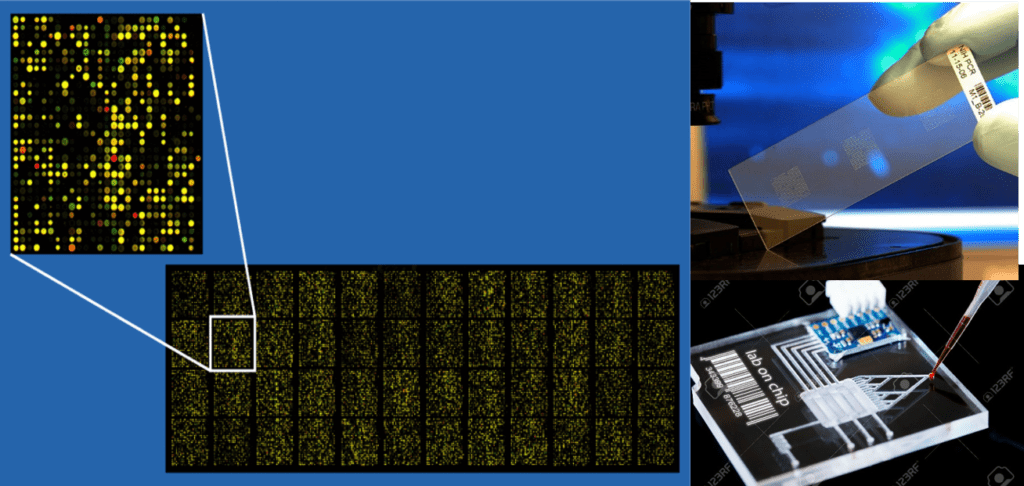
- Targeted drug delivery and effective treatment: Nanoparticles can be designed to carry drugs directly to cancer cells, and because of their photothermal and photodynamic properties, they are lethal to cancerous cells. g. CNTs, nanogold, and more.
- Tissue engineering and Regenerative medicine: Due to the bio-functionality and biocompatibility of various nanoparticles, they can help to repair or regenerate damaged tissues. g. CNTs, Dendrimers, and more.
- Antimicrobial Agent: High reactiveness and the photodynamic nature of nanoparticles make them effective agents for killing microbes. g. Nano-silver, fullerene, CNTs, and more.
- Vaccine development: Nanoparticles can be used to encapsulate antigens, and nanotechnology is used in the development of advanced vaccines such as mRNA vaccines.
- Genetic Engineering and gene therapy: Nanoparticles can be used to deliver genes, various DNA cutting enzymes to cells, and for effective DNA sequencing. g. Graphene, CNTs, and more.
- Antioxidant Agent: Nanomaterials have shown significant potential as antioxidants due to their unique properties, such as high surface area and reactivity. They can neutralize free radicals and reduce oxidative stress, which is beneficial in preventing and treating various diseases. g. Gold nanoparticles, silver nanoparticles, and carbon-based nanomaterials.
AGRICULTURE
- The agricultural sector is dealing with enormous challenges such as rapid climatic changes, a decrease in soil fertility, macro and micronutrient deficiency, overuse of chemical fertilizers and pesticides, and heavy metal presence in the soil.
- However, the global population increase has subsequently escalated food demand.
- Recent scientific research has shown that nanotechnology has the potential to positively impact the agri-food sector, minimizing adverse problems of agricultural practices on the environment and human health, improving food security and productivity, while promoting social and economic equity.
- Sustainable agriculture enhances crop production and restores and improves soil quality in the following ways:
- a) Increase the productivity using nano-pesticides and Nano-fertilizers.
- b) Improve the quality of the soil by increasing water holding capacity using Nano-zeolites and hydrogels.
- c) Stimulate plant growth using nanomaterials (SiO₂, TiO₂, and CNTs, etc.).
- d) Provide smart monitoring using Nano-sensors via wireless communication devices for precision farming.
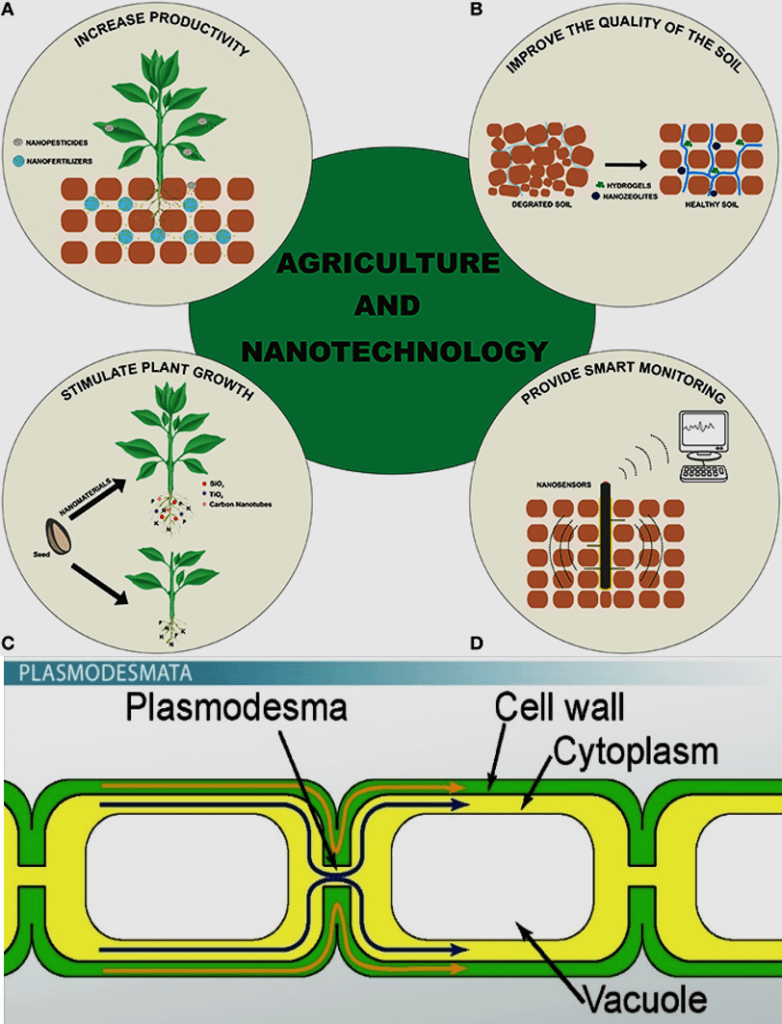
Explainer – Hydrogel and Zeolite
Hydrogel
- Hydrogel is a network of hydrophilic polymer chains that are capable of holding a large amount of water while maintaining their structure.
- Properties of Hydrogel – excellent water absorption capacity, biocompatible, and flexible polymer.
- Applications of Hydrogel –
- In medicine, they are used for wound dressings, drug delivery, tissue engineering, and making soft contact lenses. They enhance hygiene products like diapers and sanitary napkins with their absorbent properties. In agriculture, they retain soil moisture, improving crop yields. The cosmetic industry uses hydrogels in moisturizers and facial masks for hydration. In addition, they help remove microplastics from water, highlighting their broad utility.
Zeolite
- Zeolite is a family of several microporous, aluminosilicate minerals with a high surface area and well-defined crystalline structures, making them excellent commercial adsorbents and catalysts.
- Properties of Zeolite – high porosity, ion-exchange capacity, thermal stability, chemical resistance, and significant adsorptive capabilities.
- Applications of Zeolite –
- In catalysis, they are used for petroleum refining and chemical synthesis. Their ion-exchange capacity is exploited in water softening and radioactive waste treatment. Zeolites’ adsorptive properties enable gas separation and odor removal. In addition, they serve as soil conditioners in agriculture to retain nutrients and water, highlighting their broad utility.
Nano Fertilizer:
- Liquid Nano Urea
- IFFCO Nano Urea is a nanotechnology-based revolutionary Agri-input that provides nitrogen to plants. It is essentially urea in the form of a nanoparticle.
- The product has been developed at IFFCO’s Nano Biotechnology Research Centre (NBRC) at Kalol, Gujarat. IFFCO Nano Urea (liquid) is the world’s first Nanofertilizer, which has been notified by the government under Fertilizer Control Order (FCO, 1985).
- Nano Urea contains 0% total nitrogen (weight/volume). When compared to conventional urea prill, it has a desirable particle size of about 20-50 nm and more surface area. Liquid nano urea is sprayed directly on the leaves and gets absorbed by the plant.
- Fertilizers in nano form provide a targeted supply of nutrients to crops, as they are absorbed by the stomata, pores found on the epidermis of leaves. While conventional urea has an efficiency of about 25 percent, the efficiency of liquid nano urea can be as high as 85-90 percent.
- IFFCO Nano Urea is an approved product both nationally and internationally. It is in sync with OECD testing guidelines (TGs) and guidelines for Testing of Nano Agri-inputs (NAIPS) and food products by the Department of Biotechnology, Government of India.
| Explainer: Nanofertilizers
● Nanofertilizers are fertilizers that contain nanoparticles of essential nutrients, such as nitrogen, phosphorus, and potassium, which are essential for plant growth. ● A plant requires around 17 nutrients essential for plant growth and development. These nutrients have been classified into Basic, Primary, Secondary, and Micronutrients. ● Fertilizers are nutrients added to soil to enhance plant growth and increase crop yield. |
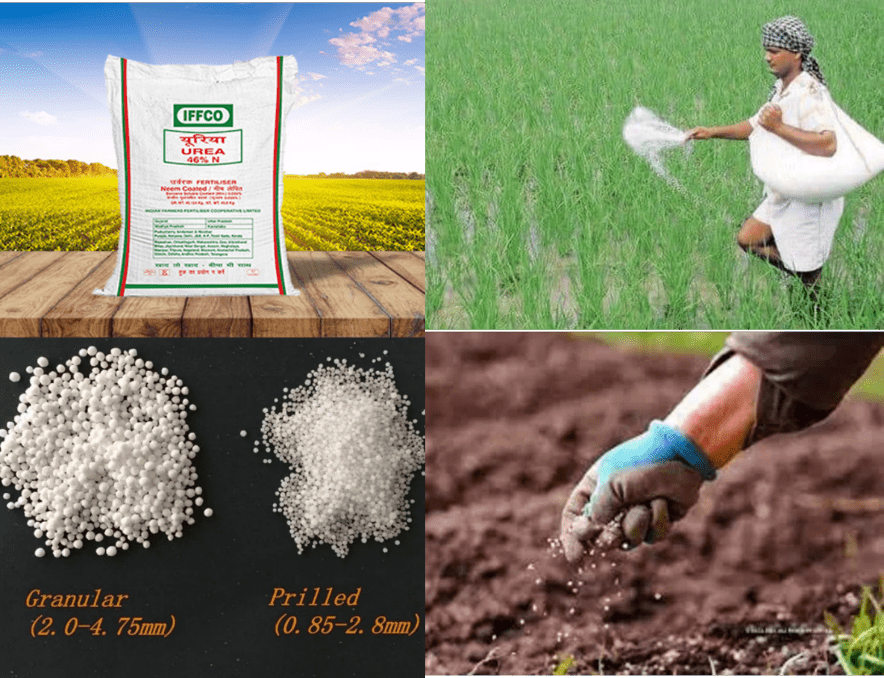
- Nano DAP – IFFCO – NBRC: India’s 2nd Nano Fertilizer under FCO, 1985
- IFFCO Nano DAP is an efficient source of available nitrogen (N) and phosphorus (P₂O₅) for all crops and helps in correcting nitrogen & phosphorus deficiencies in standing crops.
- Nano DAP formulation contains Nitrogen (8.0% N w/v) and Phosphorus (16.0% P₂O₅ w/v). Nano DAP (Liquid) has an advantage in terms of surface area to volume as its particle size is less than 100 nanometers (nm). This unique property enables it to enter easily inside the seed surface or through stomata and other plant openings.
- Nano clusters of nitrogen and phosphorus in Nano DAP are functionalized with bio-polymers and other excipients. Better spread ability and assimilation of Nano DAP inside the plant system leads to higher seed vigor, more chlorophyll, photosynthetic efficiency, better quality, and increased crop yields.
- Apart from this, Nano DAP through precision and targeted application fulfills the nutritional requirement of crops without harming the environment. Safety measures for nano DAP are similar to nano Urea.
- Benefits of Nano Fertilizers
- Nanotechnology, particularly in the form of IFFCO Nano Urea or Nano DAP, offer a range of benefits that make farming easier and more sustainable.
- One of the key advantages is the potential for higher crop yields (due to smaller size and more surface area to volume ratio), which can significantly enhance agricultural productivity and farmer income. Additionally, the use of nano urea contributes to better food quality, ensuring that the produce is healthier and more nutritious for consumers.
- Use of nanofertilizers could reduction in the usage of chemical fertilizers, thereby reducing the environmental impact of modern farming. This efficiency makes it an environment-friendly option, as it minimizes pollution and conserves natural resources. Furthermore, nano urea is easy to store and transport, which simplifies logistics and reduces costs associated with fertilizer distribution.
- Overall, the adoption of IFFCO Nano Urea highlights the transformative potential of nanotechnology in agriculture, promising a more productive, profitable, and sustainable future for farming.

- Use of nanofertilizers and concerns:
- Nanofertilizers also pose some concerns, such as the possible toxicity of nanomaterials to soil microorganisms, plants, animals, and humans. There is a lack of adequate research on the long-term effects of Nanofertilizers on soil health and food safety, and the challenges of scaling up the production, awareness, and application of Nanofertilizers.
- Therefore, Nanofertilizers need to be carefully evaluated for their advantages and risks before they can be widely adopted in agriculture.

Nanotechnology In Seed Development
- Seed quality is an important factor on which crop productivity depends.
- It has been observed that carbon nanotubes can enter the hard seed coat of tomatoes and significantly improve germination and plant growth.
- Similarly, the germination percentage increased when soybean and corn seeds were sprayed with a multiwall carbon nanotube.
Food Processing
- Nanotechnology can enhance the quality and safety of food and beverages, as well as preserve the freshness and nutritional value of food products.
- For instance, anti-bacterial products such as nano silver can be used as a materials preserver to maintain the ability to reduce odor-causing bacteria in food packaging, textiles, and other surfaces.
- Nano-sensors are being developed that can detect bacteria on the surface of food at a packaging plant and alert the consumers or manufacturers if the food is contaminated or spoiled.
- Nanoparticles are being used to deliver vitamins or other nutrients in food and beverages without affecting taste or appearance, improving the health benefits and functionality of food products. These are some ways nanotechnology can improve the food processing industry.
ENVIRONMENT AND ENERGY
- Nanotechnology has many applications in environmental engineering, such as improving the efficiency and reducing the cost of renewable energy sources, purifying and desalinating water, and cleaning up various pollutants.
- For example, silicon nanowires embedded in a polymer can result in low-cost but high-efficiency solar cells, while carbon nanotubes (CNTs) can be used to make windmill blades and fuel cells.
- Nanomembranes can filter out contaminants from water, such as salt, toxins, and bacteria. Copper tungsten oxide nanoparticles can break down oil into biodegradable compounds, which can help in oil spill remediation.
- Iron oxide nanoparticles can degrade organic solvents that pollute groundwater, and titanium oxide nanoparticles can remove radioactive uranium from groundwater. These are some of the ways that nanotechnology can contribute to a cleaner and greener environment.
ELECTRONIC – ICT – MOBILE
- Nanotechnology has revolutionized the field of electronics and information and communication technology (ICT), enabling the development of faster, smaller, and smarter devices.
- Nanotechnology has greatly improved the capacity of electronic components by reducing the size of integrated circuits’ transistors, increasing the speed and performance of processors.
- Nanotechnology has also improved the display screens of electronic devices, such as QLED and OLED, producing brighter, sharper, and more energy-efficient images.
- Nanotechnology has also reduced the power consumption, weight, and thickness of electronic devices, making them more portable, durable, and user-friendly.
- Some of the nanomaterials used in electronics and ICT are nano-semiconductor crystals, carbon nanotubes (CNTs), graphene, etc. These are some ways nanotechnology can advance the electronics and ICT industry.
Space
- In the space industry, nanotechnology plays a crucial role in the development of lightweight and strong materials for satellites and spacecrafts. Nanomaterials improve the performance and durability of components exposed to the harsh conditions of space. Carbon nanotubes, graphene, and other nanocomposites are used to create stronger and lighter structures, while nanosensors help in monitoring and maintaining onboard systems.
- Nanotechnology also contributes to advanced propulsion systems and energy storage solutions, enhancing the efficiency and capabilities of space missions.
g., Use of nanotechnology in Solar Parker Probe, Aditya L1, JWST, and more.
Other Usages
Nanotechnology has broad applications across various industries, including cosmetics, textile, construction, automotive, sports, defense, and optics.
- Construction: Nanomaterials like nano-silica, nano-clay, and titanium dioxide enhance the strength, durability, and self-cleaning properties of building materials.
- Automobile: In the automotive industry, nanotechnology improves fuel efficiency, reduces emissions, and enhances safety. Nano-coatings protect vehicle surfaces from scratches and UV damage, while nanocomposites are used to make lightweight yet strong vehicle parts.
- Sports: Nanotechnology is used to develop sports equipment that is lighter, stronger, and more durable.
g., CNTs enhance the strength of tennis rackets and bicycles. - Defence: Nanotechnology contributes to the development of advanced materials for body armor, lightweight and strong vehicle armor, and enhanced weaponry. Nanomaterials are also used in sensors for detecting chemical and biological threats and in stealth technology to reduce the visibility of military equipment.
- Optics: Nanotechnology improves optical devices and systems, such as lenses, displays, and sensors. Quantum dots enhance the color and efficiency of displays. Nano-coatings on lenses can reduce glare and increase scratch resistance.
- Cosmetics: Nanotechnology is used to create products with improved texture, stability, and performance. Nanomaterials such as zinc oxide and titanium dioxide are used in sunscreens to provide better UV protection and work as antioxidants.
- Textiles: Nanotechnology enhances the functionality of textiles by making fabrics more durable, stain-resistant, and water-repellent. Nano-coatings can provide antimicrobial properties to textiles, making them more hygienic.
CHALLENGES IN NANOTECHNOLOGY
- Health and environmental issues – leakage or work as free radicals
- Information asymmetry – no proper regulatory norms
- Governance and ethical issues
- High costs of technology
- Lack of infrastructure and human resources
PREVIOUS YEAR QUESTIONS
- Consider the following statements: [UPSC-2023]
- Carbon fibers are used in the manufacture of components in automobiles and aircrafts.
- Carbon fibers once used cannot be recycled.
Which of the statement(s) given above is/are correct? (a) 1 Only
(b) 2 Only
(c) Both 1 and 2
(d) Neither 1 nor 2
- Consider the following statements: [UPSC-2022]
- Other than those made by humans, nanoparticles do not exist in nature.
- Nanoparticles of some metallic oxides are used in the manufacture of some cosmetics.
- Nanoparticles of some commercial products which enter the environment are unsafe for humans.
Which of the statement(s) given above is/are correct?
(a) 1 Only
(b) 3 Only
(c) Only 1 and 2
(d) Only 2 and 3
- With reference to the carbon nanotubes, consider the following statement: [UPSC-2020]
- They can be used as the carriers of drugs and antigens in the human body.
- They can be made into artificial blood capillaries for an injured part of the human body.
- They can be used in biochemical sensors.
- Carbon nanotubes are biodegradable.
Which of the statements given above are correct?
(a) 1 and 2 Only
(b) 2, 3, and 4 Only
(c) 1, 3, and 4 Only
(d) 1, 2, 3, and 4
- With reference to the use of nano-technology in the health sector, which of the following statement(s) is/are correct? [UPSC-2015]
- Targeted drug delivery is made possible by nanotechnology.
- Nanotechnology can largely contribute to gene therapy.
Select the correct answer using the code given below:
(a) 1 Only
(b) 2 Only
(c) Both 1 and 2
(d) Neither 1 nor 2
- There is some concern regarding the nanoparticles of some chemical elements that are used by the industry in the manufacture of various products. Why? [UPSC-2014]
- They can accumulate in the environment and contaminate water and soil.
- They can enter the food chains.
- They can trigger the production of free radicals.
Select the correct answer using the code given below:
(a) 1 and 2 Only
(b) 3 Only
(c) 1 and 3 Only
(d) 1, 2, and 3
- Graphene is frequently in news recently, what is its importance? [UPSC-2012]
- It is a two-dimensional material and has good electrical conductivity.
- It is one of the thinnest but strongest materials tested so far.
- It is entirely made of silicon and has high optical transparency.
- It can be used as conducting electrodes required for touch screens, LCDs, and organic LEDs.
Which of the statements given above are correct?
(a) 1 and 2 Only
(b) 3 and 4 Only
(c) Only 1, 2, and 4
(d) 1, 2, 3, and 4
- How can the height of a person who is six feet tall be expressed (approximately) in Nanometers? [UPSC-2008]
(a) 183 × 10⁶ nanometres
(b) 234 × 10⁶ nanometres
(c) 183 × 10⁷ nanometres
(d) 234 × 10⁷ nanometres
- A particle having at least one dimension less than 10⁻⁷ meter is known as [RAS-2018]
(a) Micro particle
(b) Milli particle
(c) Nano particle
(d) Macro particle
- If in a material one dimension is reduced to the Nano range while the other two dimensions remain large, the structure so obtained is known as [RAS-2023]
(a) Quantum step
(b) Quantum well
(c) Quantum dot
(d) Quantum wire
- Nanotechnology is related to [RAS-2013]
(a) Atomic engineering
(b) Carbon engineering
(c) Microbiology
(d) Microphysics
- Consider the following statements: [RAS-2013]
- Nanotechnology is based on nanometre scale.
- Nanomaterials may be characterized by electron microscopy.
- Plasma synthesis is the physical technique for synthesis of nanomaterials.
Which of the above statement(s) is/are true?
(a) 2 and 3 only
(b) 1 and 3 only
(c) 1 and 2 only
(d) All
- Which one of the following statements is correct? [RAS-2013]
(a) Nano-ear can detect sound levels as low as -120 dB
(b) Nano-ear can detect sound as low as -60 dB
(c) Nano-ear consists of a single silica nanoparticle
(d) Nano-ear consists of a single silver nanoparticle
Practice Questions
- Which of the following is/are applications of nanotechnology in the health sector?
- Can help in Eye surgery
- Detection of heart attack
- Drug delivery
- Removing toxins from the bloodstream
Select the correct answer using the code given below:
(a) 1 only
(b) 2 and 3 only
(c) 3 and 4 only
(d) 1, 2, 3 and 4
- Consider the following statements:
- Graphene is the most electrically and thermally conductive material in the world.
- Graphene has applications in faster DNA sequencing and drug delivery.
Which of the statement(s) given above is/are correct?
(a) 1 only
(b) 2 only
(c) Both 1 and 2
(d) Neither 1 nor 2
- Consider the following statements about LIQUID NANO UREA PLANT at Kalol (Gujarat):
- It is the world’s first nano urea (liquid) plant.
- Nano Urea Liquid (NUL) reduces the requirement of conventional urea by 50% or more.
- NUL contains nano-scale phosphorus particles which have more surface area and number of particles making it more impactful.
Which of the statement(s) given above is/are correct? (a) Only 1
(b) Only 2 and 3
(c) Only 1 and 2
(d) Only 1 and 3
- With reference to Carbon NanoTubes (CNT), consider the following statements:
- CNTs are 3D structures made up of carbon in tube-like structure.
- Unique structure of CNTs makes them appealing for drug delivery and biosensing platforms for the treatment of a variety of diseases.
- CNTs are not thermally and electrically conductive but have high mechanical strength.
Which of the statements given above are correct? (a) 1 and 2 only
(b) 2 only
(c) 2 and 3 only
(d) 1, 2, and 3
- With reference to Graphene, which of the following(s) is/are the applications of Graphene?
- Enhancing the storage capacity of batteries.
- Fastening the DNA sequencing.
- Used as Bio-Chemical Sensors.
- Water Purifier.
- Used as Nanoantenna.
Select the correct answer using the code given below: (a) 1, 2, 3, and 4 only
(b) 1, 3, and 5 only
(c) 2, 3, 4, and 5 only
(d) 1, 2, 3, 4, and 5
- With respect to Nano Mission, consider the following statements:
- It is the initiative of the Department of Science and Technology in collaboration with NITI Aayog.
- In this initiative, ₹10,000 crore allocated to this mission in order to promote nanotechnology in aspirational districts.
- It is launched in Budget 2023-24.
Which of the statements given above are incorrect? (a) 1 and 2 only
(b) 2 and 3 only
(c) 1 and 3 only
(d) 1, 2, and 3
- Recently, The Department of Fertilizers conducted an audit which revealed a variation of 25-50% in the reduction of nitrogen use after the application of nano urea. In the above context, which one of the following are the benefits for nano urea?
- Protect the crop from lodging effects
- Improve the effectiveness of nitrogen delivery
- Enhance the quality of Groundwater
Select the correct answer using the code given below:
(a) 1 and 2 only
(b) 2 and 3 only
(c) 1 and 3 only
(d) 1, 2, and 3
- Consider the following statements:
- They are zero-dimensional (0D) carbon nanomaterials with lateral diameters <10 nm.
- They can be useful for water treatment.
- They are inexpensive, highly biocompatible, and environment-friendly.
Which one of the following options suits the above statements?
(a) Graphene
(b) Carbon Nanotubes
(c) Carbon Dots
(d) Lipids
Answer Key
| Question | 1 | 2 | 3 | 4 | 5 | 6 | 7 | 8 | 9 | 10 |
| Answer | a | d | c | c | d | c | c | c | b | a |
| Question | 11 | 12 | 13 | 14 | 15 | 16 | 17 | 18 | 19 | 20 |
| Answer | d | b | d | c | c | b | d | d | d | c |
Mains Questions
- Why is nanotechnology one of the key technologies of the 21st century? Describe the salient features of Indian Government’s Mission on Nanoscience and Technology and the scope of its application in the development process of the country. (200 Words)
[UPSC-2016]
- What do you understand by nanotechnology and how is it helping in the health sector? (150 Words)
[UPSC-2020]
- What are nano-fertilizers? Explain with the help of certain examples. Discuss the associated benefits and the concerns raised with their usages. (150 Words)
